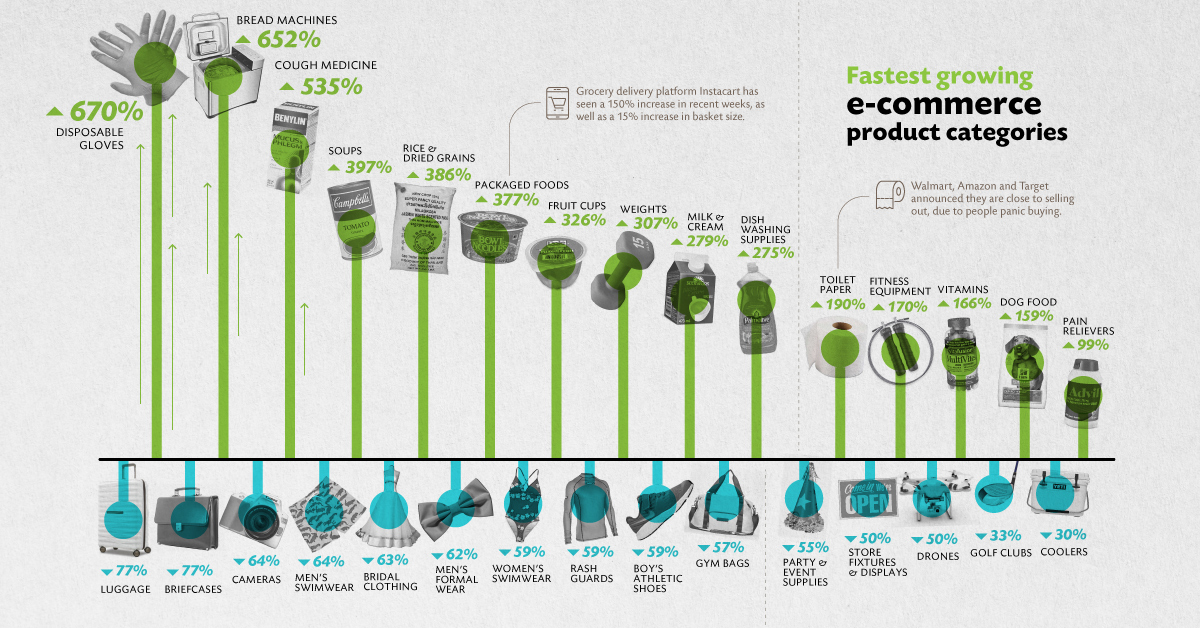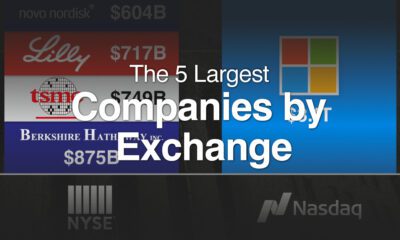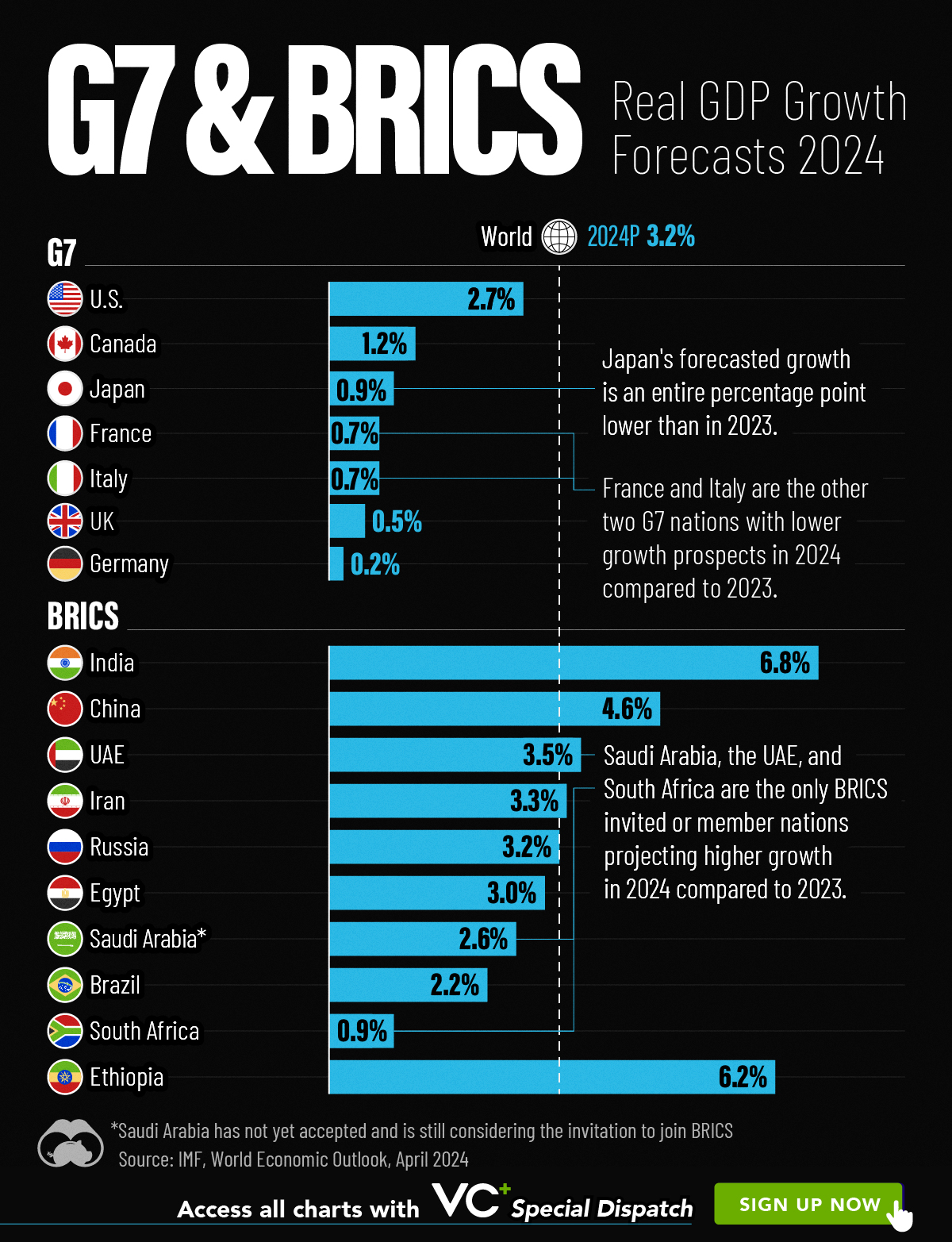Markets
The Pandemic Economy: What are Shoppers Buying Online During COVID-19?
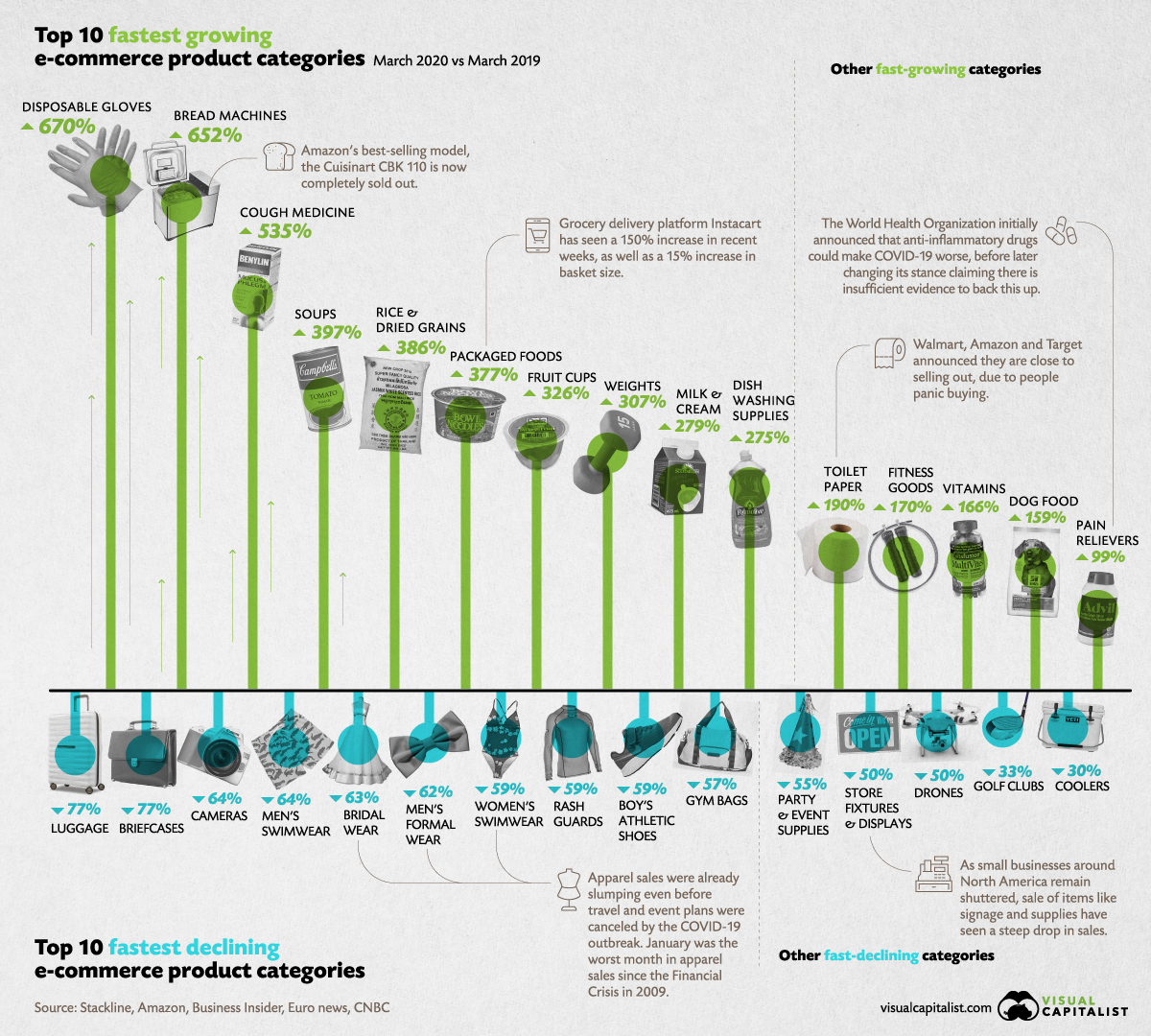
The Fastest Growing and Declining E-Commerce Categories
The COVID-19 pandemic is having a significant impact on every aspect of life, including how people shop for their necessities, and their not-so-necessities.
With online retail sales estimated to reach an eye-watering $6.5 trillion by 2023, the ecommerce sector was already booming. But since the outbreak, online shopping has been catapulted into complete overdrive. Even the largest retailers on the planet are struggling to keep up with the unprecedented consumer demand—but what exactly are people buying?
To answer this question, retail intelligence firm Stackline analyzed ecommerce sales across the U.S. and compiled a list of the fastest growing and declining ecommerce categories (March 2020 vs. March 2019) with surprising results.
The Frenzy of Buyer Behavior
As people come to terms with their new living situations, their buying behavior has adapted to suit their needs. While panic buying may have slowed in some countries, consumers continue to stock up on supplies, or “pandemic pantry products”.
Many consumers are also using their newfound time to focus on their health, with 85% of consumers taking up some kind of exercise while in social isolation, and 40% of them saying they intend to keep it up when restrictions are lifted.
These changing behaviors have resulted in a number of product categories experiencing a surge in demand — and although a lot of them are practical, others are wonderfully weird.
The Fastest Growing Categories
While the below list features several shelf-stable items, it seems as though consumers are taking matters into their own hands, with bread making machines sitting in second place and retailers selling out of their top models.
It’s clear from the list that consumers are considering positive changes to their lifestyle while in isolation, as fitness, smoking cessation, and respiratory categories are all experiencing growth.
Explore the 100 fastest growing product categories below:
| Rank | Category | % Change in March (2020 vs. 2019) |
|---|---|---|
| #1 | Disposable Gloves | 670% |
| #2 | Bread Machines | 652% |
| #3 | Cough & Cold | 535% |
| #4 | Soups | 397% |
| #5 | Dried Grains & Rice | 386% |
| #6 | Packaged Foods | 377% |
| #7 | Fruit Cups | 326% |
| #8 | Weight Training | 307% |
| #9 | Milk & Cream | 279% |
| #10 | Dishwashing Supplies | 275% |
| #11 | Paper Towels | 264% |
| #12 | Hand Soap & Sanitizer | 262% |
| #13 | Pasta | 249% |
| #14 | Vegetables | 238% |
| #15 | Flour | 238% |
| #16 | Facial Tissues | 235% |
| #17 | Allergy Medicine | 232% |
| #18 | Women’s Health | 215% |
| #19 | Cereals | 214% |
| #20 | Power Generators | 210% |
| #21 | Laundry Supplies | 200% |
| #22 | Household Cleaners | 195% |
| #23 | Soap & Body Wash | 194% |
| #24 | Toilet Paper | 190% |
| #25 | Jerky & Dried Meats | 187% |
| #26 | Chips & Pretzels | 186% |
| #27 | Crackers | 184% |
| #28 | Health Monitors | 182% |
| #29 | Popcorn | 179% |
| #30 | Computer Monitors | 172% |
| #31 | Fitness Equipment | 170% |
| #32 | Single Vitamins | 166% |
| #33 | Nut & Seed Butters | 163% |
| #34 | Cat Food | 162% |
| #35 | Fruit Snacks | 162% |
| #36 | Baby Care Products | 162% |
| #37 | Refrigerators | 160% |
| #38 | Baking Mixes | 160% |
| #39 | Toilet Accessories | 160% |
| #40 | Dog Food | 159% |
| #41 | Diapers | 154% |
| #42 | Yoga Equipment | 154% |
| #43 | Bottled Beverages | 153% |
| #44 | Baby Meals | 153% |
| #45 | Cookies | 147% |
| #46 | Digestion & Nausea | 144% |
| #47 | Snack Foods | 141% |
| #48 | Herbal Supplements | 136% |
| #49 | Cooking Oils | 135% |
| #50 | Water | 130% |
| #51 | Incontinence & Tummy | 129% |
| #52 | Mutivitamin | 126% |
| #53 | Cat Litter | 125% |
| #54 | Training Pads and Trays | 125% |
| #55 | Juices | 125% |
| #56 | Smoking Cessation | 122% |
| #57 | Dried Fruit & Raisins | 120% |
| #58 | Salt & Pepper Seasoning | 118% |
| #59 | Craft Kits & Projects | 117% |
| #60 | Batteries | 116% |
| #61 | Trash Bags | 116% |
| #62 | Nuts & Seeds | 116% |
| #63 | Hair Coloring | 115% |
| #64 | Sauce & Gravy | 115% |
| #65 | Deli Foods | 114% |
| #66 | Syrups | 114% |
| #67 | Breads & Bakery | 114% |
| #68 | Minerals | 113% |
| #69 | Condiments | 111% |
| #70 | First Aid | 108% |
| #71 | Nail Care | 108% |
| #72 | Humidifiers | 105% |
| #73 | Art Paint | 104% |
| #74 | Office Chairs | 104% |
| #75 | Deodorant | 103% |
| #76 | Jams, Jellies & Spreads | 102% |
| #77 | Coffee | 101% |
| #78 | Spices & Seasoning | 100% |
| #79 | Skin Care | 99% |
| #80 | Pain Relievers | 99% |
| #81 | Cooking Vinegars | 98% |
| #82 | Air Purifiers | 97% |
| #83 | Granola & Nutrition Bars | 97% |
| #84 | Pudding & Gelatin | 97% |
| #85 | Toy Clay & Dough | 95% |
| #86 | Single Spices | 95% |
| #87 | Bird Food & Treats | 91% |
| #88 | Lab & Science Products | 90% |
| #89 | Eczema & Psoriasis | 90% |
| #90 | Ping Pong | 89% |
| #91 | Chocolate | 86% |
| #92 | Baking Ingredients | 84% |
| #93 | Energy Supplements | 84% |
| #94 | Respiratory | 82% |
| #95 | Office Desks | 82% |
| #96 | Potty Training Supplies | 82% |
| #97 | Herbs, Spices & Seasonings | 82% |
| #98 | Keyboard & Mice | 80% |
| #99 | Body Lotion | 79% |
| #100 | Safes | 69% |
Interestingly, toilet paper has seen more growth than baby care products, and cured meats have seen more growth than water. But while some categories are experiencing a drastic increase in demand, others are slumping in the pandemic economy.
The Fastest Declining Categories
An unprecedented wave of event and vacation cancellations is having a huge impact on the products people consume. For instance, luggage and suitcases, cameras, and men’s swimwear have all seen a dip in sales.
See the full list of 100 fastest declining categories below:
| Rank | Category | % Change in March (2020 vs. 2019) |
|---|---|---|
| #1 | Luggage & Suitcases | -77% |
| #2 | Briefcases | -77% |
| #3 | Cameras | -64% |
| #4 | Men’s Swimwear | -64% |
| #5 | Bridal Clothing | -63% |
| #6 | Men's Formal Wear | -62% |
| #7 | Women’s Swimwear | -59% |
| #8 | Rash Guards | -59% |
| #9 | Boy’s Athletic Shoes | -59% |
| #10 | Gym Bags | -57% |
| #11 | Backpacks | -56% |
| #12 | Snorkelling Equipment | -56% |
| #13 | Girl’s Swimwear | -55% |
| #14 | Baseball Equipment | -55% |
| #15 | Event & Party Supplies | -55% |
| #16 | Motorcycle Protective Gear | -55% |
| #17 | Camera Bags & Cases | -54% |
| #18 | Women’s Suits & Dresses | -53% |
| #19 | Women’s Boots | -51% |
| #20 | Cargo Racks | -51% |
| #21 | Women’s Sandals | -50% |
| #22 | Drones | -50% |
| #23 | Boy's Active Clothing | -50% |
| #24 | Lunch Boxes | -50% |
| #25 | Store Fixtures & Displays | -50% |
| #26 | Automotive Mats | -50% |
| #27 | Men’s Outerwear | -49% |
| #28 | Watches & Accessories | -49% |
| #29 | Cargo Bed Covers | -48% |
| #30 | Track & Field Equipment | -48% |
| #31 | Ceiling Lighting | -47% |
| #32 | Camera Lenses | -47% |
| #33 | Girl’s Coats and Jackets | -47% |
| #34 | Women’s Hats & Caps | -47% |
| #35 | Women's Outerwear | -47% |
| #36 | Video Cameras | -46% |
| #37 | Wheels & Tires | -46% |
| #38 | Motorcycle Parts | -45% |
| #39 | Women’s Wallets | -45% |
| #40 | Shocks & Struts | -44% |
| #41 | Transmission & Parts | -44% |
| #42 | Girl’s Athletic Shoes | -44% |
| #43 | Women’s Shoes | -44% |
| #44 | Telescopes | -44% |
| #45 | Sunglasses & Eyeglasses | -43% |
| #46 | Men’s Tops | -41% |
| #47 | Video Projectors | -40% |
| #48 | Men’s Athletic Shoes | -40% |
| #49 | Marine Electronics | -40% |
| #50 | Hand Tools | -40% |
| #51 | Wine Racks | -40% |
| #52 | Men's Shoes | -40% |
| #53 | Clocks | -39% |
| #54 | Baby Girl’s Shoes | -39% |
| #55 | Bracelets | -39% |
| #56 | Men’s Boots | -39% |
| #57 | Tapestries | -39% |
| #58 | Camping Equipment | -39% |
| #59 | Men’s Bottoms | -38% |
| #60 | Cell Phones | -38% |
| #61 | Tool Storage & Organizers | -38% |
| #62 | Necklaces | -38% |
| #63 | Swimming Equipment | -37% |
| #64 | Men’s Hats & Caps | -37% |
| #65 | Girl’s Shoes | -37% |
| #66 | Industrial Tools | -36% |
| #67 | Juicers | -36% |
| #68 | Desktops | -35% |
| #69 | Classroom Furniture | -35% |
| #70 | Bar & Wine Tools | -35% |
| #71 | Glassware & Drinkware | -35% |
| #72 | Musical Instruments | -34% |
| #73 | Power Winches | -34% |
| #74 | Home Bar Furniture | -34% |
| #75 | Office Storage Supplies | -34% |
| #76 | Girl's Active Clothing | -34% |
| #77 | Women’s Tops | -34% |
| #78 | Braces, Splints & Supports | -34% |
| #79 | Car Anti-theft | -34% |
| #80 | Rings | -34% |
| #81 | Blankets & Quilts | -33% |
| #82 | Women's Athletic Shoes | -33% |
| #83 | Kitchen Sinks | -33% |
| #84 | Golf Clubs | -33% |
| #85 | Equestrian Equipment | -33% |
| #86 | GPS & Navigation | -32% |
| #87 | Recording Supplies | -32% |
| #88 | Home Audio | -32% |
| #89 | Boy's Accessories | -32% |
| #90 | Earrings | -32% |
| #91 | Dining Sets | -31% |
| #92 | Calculators | -31% |
| #93 | Boy's Shoes | -31% |
| #94 | Volleyball Equipment | -31% |
| #95 | Strollers | -31% |
| #96 | Coolers | -30% |
| #97 | Sanders & Grinders | -30% |
| #98 | Men's Activewear | -29% |
| #99 | Living Room Furniture | -29% |
| #100 | Climbing & Hiking Bags | -28% |
Regardless of which list a product falls under, it is clear that the pandemic has impacted retailers of every kind in both positive and negative ways.
The New Normal?
Officially the world’s largest retailer, Amazon has announced it can no longer keep up with consumer demand. As a result, it will be delaying the delivery of non-essential items, or in some cases not taking orders for non-essentials at all.
This presents a double-edged sword, as the new dynamic that is bringing some retailers unprecedented demand could also bring about an untimely end for others.
Meanwhile, the question remains: will this drastic change in consumer behavior stabilize once we flatten the curve, or is this our new normal?
Economy
Economic Growth Forecasts for G7 and BRICS Countries in 2024
The IMF has released its economic growth forecasts for 2024. How do the G7 and BRICS countries compare?
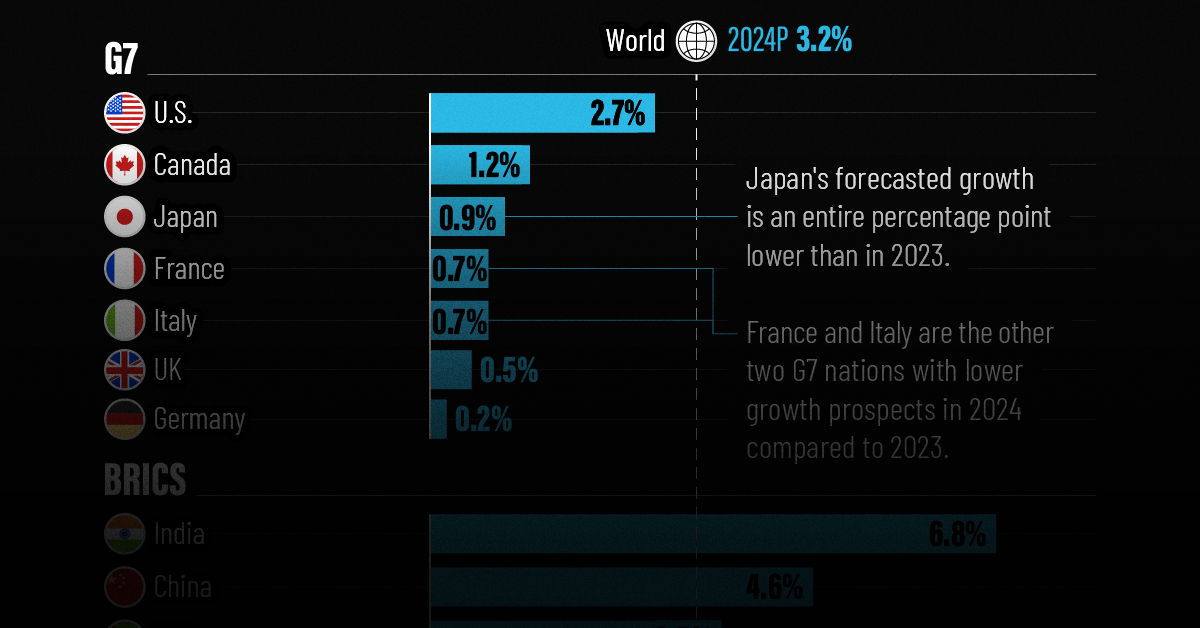
G7 & BRICS Real GDP Growth Forecasts for 2024
The International Monetary Fund’s (IMF) has released its real gross domestic product (GDP) growth forecasts for 2024, and while global growth is projected to stay steady at 3.2%, various major nations are seeing declining forecasts.
This chart visualizes the 2024 real GDP growth forecasts using data from the IMF’s 2024 World Economic Outlook for G7 and BRICS member nations along with Saudi Arabia, which is still considering an invitation to join the bloc.
Get the Key Insights of the IMF’s World Economic Outlook
Want a visual breakdown of the insights from the IMF’s 2024 World Economic Outlook report?
This visual is part of a special dispatch of the key takeaways exclusively for VC+ members.
Get the full dispatch of charts by signing up to VC+.
Mixed Economic Growth Prospects for Major Nations in 2024
Economic growth projections by the IMF for major nations are mixed, with the majority of G7 and BRICS countries forecasted to have slower growth in 2024 compared to 2023.
Only three BRICS-invited or member countries, Saudi Arabia, the UAE, and South Africa, have higher projected real GDP growth rates in 2024 than last year.
| Group | Country | Real GDP Growth (2023) | Real GDP Growth (2024P) |
|---|---|---|---|
| G7 | 🇺🇸 U.S. | 2.5% | 2.7% |
| G7 | 🇨🇦 Canada | 1.1% | 1.2% |
| G7 | 🇯🇵 Japan | 1.9% | 0.9% |
| G7 | 🇫🇷 France | 0.9% | 0.7% |
| G7 | 🇮🇹 Italy | 0.9% | 0.7% |
| G7 | 🇬🇧 UK | 0.1% | 0.5% |
| G7 | 🇩🇪 Germany | -0.3% | 0.2% |
| BRICS | 🇮🇳 India | 7.8% | 6.8% |
| BRICS | 🇨🇳 China | 5.2% | 4.6% |
| BRICS | 🇦🇪 UAE | 3.4% | 3.5% |
| BRICS | 🇮🇷 Iran | 4.7% | 3.3% |
| BRICS | 🇷🇺 Russia | 3.6% | 3.2% |
| BRICS | 🇪🇬 Egypt | 3.8% | 3.0% |
| BRICS-invited | 🇸🇦 Saudi Arabia | -0.8% | 2.6% |
| BRICS | 🇧🇷 Brazil | 2.9% | 2.2% |
| BRICS | 🇿🇦 South Africa | 0.6% | 0.9% |
| BRICS | 🇪🇹 Ethiopia | 7.2% | 6.2% |
| 🌍 World | 3.2% | 3.2% |
China and India are forecasted to maintain relatively high growth rates in 2024 at 4.6% and 6.8% respectively, but compared to the previous year, China is growing 0.6 percentage points slower while India is an entire percentage point slower.
On the other hand, four G7 nations are set to grow faster than last year, which includes Germany making its comeback from its negative real GDP growth of -0.3% in 2023.
Faster Growth for BRICS than G7 Nations
Despite mostly lower growth forecasts in 2024 compared to 2023, BRICS nations still have a significantly higher average growth forecast at 3.6% compared to the G7 average of 1%.
While the G7 countries’ combined GDP is around $15 trillion greater than the BRICS nations, with continued higher growth rates and the potential to add more members, BRICS looks likely to overtake the G7 in economic size within two decades.
BRICS Expansion Stutters Before October 2024 Summit
BRICS’ recent expansion has stuttered slightly, as Argentina’s newly-elected president Javier Milei declined its invitation and Saudi Arabia clarified that the country is still considering its invitation and has not joined BRICS yet.
Even with these initial growing pains, South Africa’s Foreign Minister Naledi Pandor told reporters in February that 34 different countries have submitted applications to join the growing BRICS bloc.
Any changes to the group are likely to be announced leading up to or at the 2024 BRICS summit which takes place October 22-24 in Kazan, Russia.
Get the Full Analysis of the IMF’s Outlook on VC+
This visual is part of an exclusive special dispatch for VC+ members which breaks down the key takeaways from the IMF’s 2024 World Economic Outlook.
For the full set of charts and analysis, sign up for VC+.
-

 Markets1 week ago
Markets1 week agoU.S. Debt Interest Payments Reach $1 Trillion
-

 Business2 weeks ago
Business2 weeks agoCharted: Big Four Market Share by S&P 500 Audits
-

 Real Estate2 weeks ago
Real Estate2 weeks agoRanked: The Most Valuable Housing Markets in America
-

 Money2 weeks ago
Money2 weeks agoWhich States Have the Highest Minimum Wage in America?
-

 AI2 weeks ago
AI2 weeks agoRanked: Semiconductor Companies by Industry Revenue Share
-

 Markets2 weeks ago
Markets2 weeks agoRanked: The World’s Top Flight Routes, by Revenue
-

 Demographics2 weeks ago
Demographics2 weeks agoPopulation Projections: The World’s 6 Largest Countries in 2075
-

 Markets2 weeks ago
Markets2 weeks agoThe Top 10 States by Real GDP Growth in 2023




